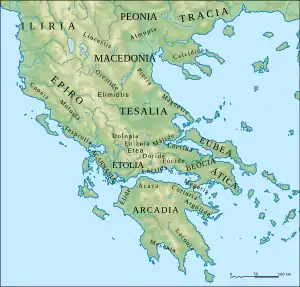
Elaea or Elaia (Ancient Greek: Ἐλαία), also Elea (Ἐλέα), was a town of Thesprotia in ancient Epirus toward the mouth of the Acheron river. The town is mentioned by Ptolemy. Thucydides calls the surrounding district Elaeatis (Ἐλαιατις) and indicates that Ephyra was in the territory of Elaea.[1] Its port was Elaias Limen, literally the "Bay of Elaea", which the Periplus of Pseudo-Scylax asserts was the main port of Thesprotia.[2]
Coins ascribed to the town, with the inscription "ΕΛΕΑΤΑΝ" or "ΕΛΕΑΙ", have been found that have been dated c. 360–335 BCE.[3]
The town's site is identified as near Chrysavgi,[4][5] where archaeological exploration has taken place.
Gallery
 Aerial view of the Archaeological site of Elaea
Aerial view of the Archaeological site of Elaea Walls and gate of Elaea
Walls and gate of Elaea Ruins of the Agora
Ruins of the Agora Ruins in Elaea
Ruins in Elaea Gate of Elaea
Gate of Elaea Model of the excavated ruins in Elaea
Model of the excavated ruins in Elaea
References
- ↑ Thucydides. History of the Peloponnesian War. Vol. 1.46.
- ↑ Periplus of Pseudo-Scylax 30.
- ↑ Mogens Herman Hansen & Thomas Heine Nielsen (2004). "Epirus". An inventory of archaic and classical poleis. New York: Oxford University Press. pp. 344–345. ISBN 0-19-814099-1.
- ↑ Richard Talbert, ed. (2000). Barrington Atlas of the Greek and Roman World. Princeton University Press. p. 54, and directory notes accompanying.
- ↑ Lund University. Digital Atlas of the Roman Empire.
- Smith, William (editor); Dictionary of Greek and Roman Geography, "Acheron", London, (1854)
- Richard Talbert, Barrington Atlas of the Greek and Roman World, (ISBN 0-691-03169-X), p. 54
See also
![]() This article incorporates text from a publication now in the public domain: Smith, William, ed. (1854–1857). "Acheron". Dictionary of Greek and Roman Geography. London: John Murray.
This article incorporates text from a publication now in the public domain: Smith, William, ed. (1854–1857). "Acheron". Dictionary of Greek and Roman Geography. London: John Murray.
39°26′24″N 20°33′02″E / 39.4399°N 20.55057°E